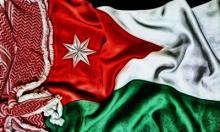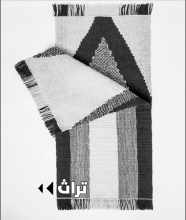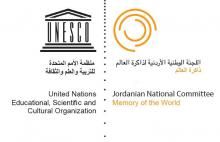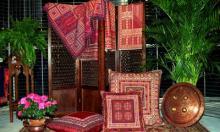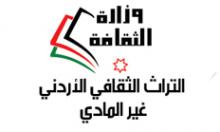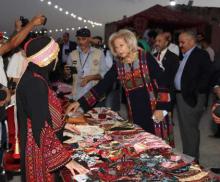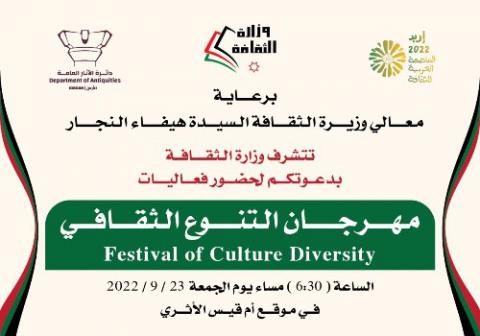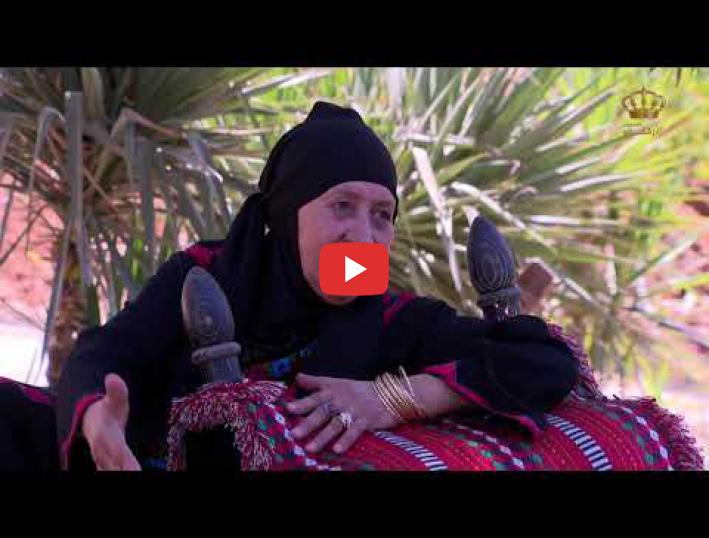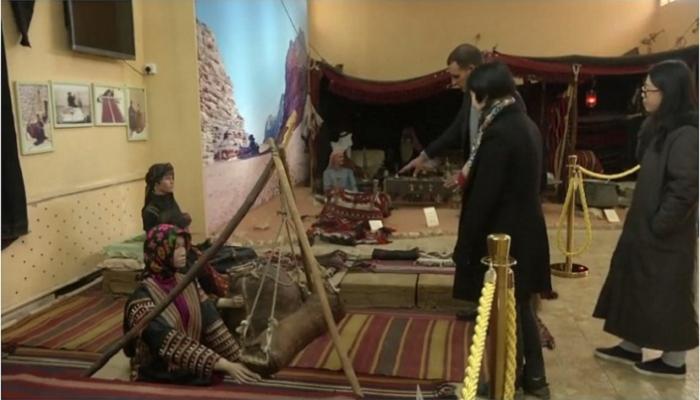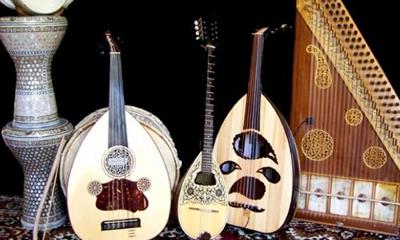- الرئيسية
- مديرية التراث
- نبذه عن المديرية
المزيدأولاً: نشأة المديرية تم تأسيس مديرية التراث في نهاية عام 2010 وذلك حرصاً من وزارة الثقافة على رعاية وصون التراث الثقافي غير المادي في المملكة الاردنية الهاشمية. «التراث الثقافي غير المادي » الممارسات والتصورات وأشكال التعبير والمعارف والمهارات - وما يرتبط بها من آلات وقطع ومصنوعات وأماكن ثقافية...
- أهداف مديرية التراث
- اقسام المديرية
المزيدأقسام مديرية التراث: 1- قسم البرامج التراثية : من أبرز مهامه تنظيم وتنفيذ ومتابعة المشاريع والبرامج والأنشطة المتعلقة بالتراث الثقافي غير المادي ضمن خطة المديرية والجهات ذات العلاقة، ومتابعة الاتفاقيات التي تعقدها المملكة مع المنظمات والهيئات الدولية لغايات تنفيذ المشاريع التي تقع ضمن نطاقها. 2...
- الاصدارات المزيد
- التعليمات والاتفاقيات المزيد
- نبذه عن المديرية
المزيد
- المشاريع
- مشروع المكنز الوطني
المزيداختصاصات لجنة ذاكرة العالم الأردنية الاسم: Jordanian Memory of the World committee اللجنة الأردنية لذاكرة العالم الهيكل: تتألف لجنة ذاكرة العالم الأردنية من لجنة رفيعة المستوى و 4 لجان فرعية متخصصة في مختلف جوانب اللجنة. الوظيفة: ستضطلع لجنة ذاكرة العالم في الأردن بمسؤولية...
- المشروع الوطني لحصر التراث
المزيدنبذة عن المشروع يهدف هذا المشروع إلى حصر التراث الثقافي غير المادي في كافة محافظات المملكة الأردنية الهاشمية، وبالتزامن. كما يهدف إلى إشراك المجتمع المحلي في الجرد، وإنشاء قاعدة بيانات شاملة، وتحديد عناصر التراث الثقافي غير المادي المهدّدة بالانقراض، ورفع الوعي بأهمية التراث الثقافي غير المادي حتى...
- مشروع تفريغ و أرشفة أشرطة الكاسيت المسجلة في أواسط السبعينيات
المزيدمشروع إعادة تأهيل المادة الصوتية المسجّلة في السبعينيات من القرن الماضي. (الذاكرة المسجّلة في أشرطة الكاسيت التقليدية) للحفاظ على الموروث الأردني الثقافي، والكنز الذي قامت بتسجيله نخبة من الباحثين في التراث في أواسط السبعينيات، وفي مناطق مختلفة من المملكة، ارتأت مديرية التراث أن يصار إلى البحث عن...
- برنامج ذاكرة العالم
المزيداختصاصات لجنة ذاكرة العالم الأردنية الاسم: Jordanian Memory of the World committee اللجنة الأردنية لذاكرة العالم الهيكل: تتألف لجنة ذاكرة العالم الأردنية من لجنة رفيعة المستوى و 4 لجان فرعية متخصصة في مختلف جوانب اللجنة. الوظيفة: ستضطلع لجنة ذاكرة العالم في الأردن بمسؤولية...
- مشاريع مدن الثقافة
المزيد
المشاريع
تم تخصيص جزء من مخصصات مدن الثقافة والالوية في الاعوام السابقة لدعم مشاريع تراثية تُعنى في الحفاظ على الموروث الشعبي الاردني وتسويق المنتج التراثي ودعم الافراد والجمعيات والفرق التراثية. حيث قامت مديرية التراث بالتنسيب بدعم المشاريع التي تحقق روية ورسالة المديرية وتسلط الضوء على المنتج التراثي... - مهرجان التنوع الثقافي
المزيد
المشاريع
يأتي ضمن احتفالات العالم باليوم العالمي للتنوع الثقافي الذي يصادف 16/5 من كل عام، ويهدف هذا المهرجان إلى الحفاظ على النسيج الاجتماعي الاردني وتعزيز الترابط بين كافة أفراد المجتمع الأردني وإبراز نسيج الحضارة الأردنية وجماليات التنوع الثقافي في الأردن والتعريف بالهوية الثقافية المتميزة لدى الأردن... - ترشيح العناصر على قوائم التراث الثقافي غير المادي
المزيد
المشاريع
بعد ان يتم حصر عناصر التراث الثقافي غير المادي في المملكة وادراجها على قوائم الحصر لدى مديرية التراث، تقوم المديرية وبالتنسيق مع مؤسسات المجتمع المدني بترشيح عناصر مختارة على قوائم اليونسكو للتراث غير المادي. إن ترشيح عنصر واحد على قوائم التراث سواء كان ملف وطني أو مشترك يستغرق عامين ويتطلب تحضير... - العناصر الاردنية المدرجة على قوائم اليونسكو
المزيد
المشاريع
تم ترشيح ملف (العادات والتقاليد والممارسات المتعلقة برقصة السامر) في الاردن على القائمة التمثيلية للتراث الثقافي غير المادي للإنسانية، وستعلن نتائج الترشيح خلال شهر تشرين الثاني من العام 2018. ترشيح ملف النخلة والعادات والطقوس المرتبطة بها: تراثاً عربياً مشتركاً على القائمة التمثيلية للتراث...
- مشروع المكنز الوطني
المزيد
- المركز الإعلامي
- قواعد البيانات
- قاعدة بيانات المكنز الوطني
المزيد
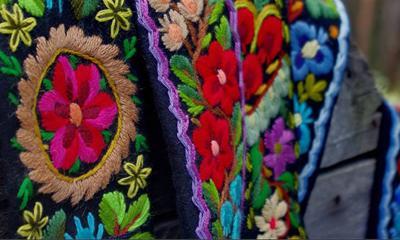
- قوائم الحصر الوطني
المزيد
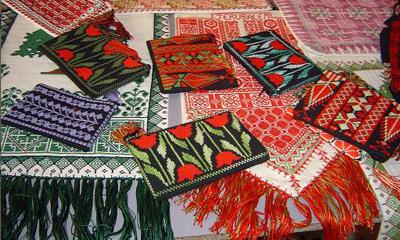
- قاعدة بيانات الحرفيين
المزيد
قاعدة بيانات الحرفيين
- قاعدة بيانات المكنز الوطني
المزيد

المنسف AlMansaf
التصنيف:
- التقاليد وأشكال التعبير الشفهي بما في ذلك اللغة
- التقاليد
- تقاليد الطعام
- الاكلات الشعبية
المحافظة:
الشرح:
|
المنسف: وليمة احتفائية ودلالاته الاجتماعية والثقافية المنسف: وليمة احتفائية ودلالاته الاجتماعية والثقافية هو الطبق التقليدي الأكثر شعبية. ويشكل مظهر ورمز ثقافي يحظى بتقدير كبير ، ويشتمل على دلالات قوية وعميقة للهوية، والتماسك الاجتماعي، والتضامن، والتعبير عن الأمن والشعور بالهوية والأخلاق ؛ ناهيك عن القيم الاجتماعية المتعددة الأخرى التي يتضمنها. كما ويرتبط المنسف بالثقافة الأردنية التقليدية القائمة على نمط الحياة الزراعية الرعوية التي تتوفر فيها اللحوم واللبن بسهولة. ويتم تقديم المنسف في جميع المناسبات الكبرى والاحتفالات؛ كحفلات الزفاف والولادة، ولتكريم الضيوف، والاحتفال بالأعياد الدينية الكبرى والعديد من المناسبات الأخرى. يتكون الطبق من اللحم المطبوخ في سائل مخفف من كتل الزبادي المجففة والمخمرة تسمى (Jameed)المصنوع من حليب الماعز أو الأغنام. يتم غلي قطع مكتنزة من لحم الضأن، ويضيف الطباخ الجميد في الوعاء لطهيهما معا. يتم تقديم هذا الخليط المطبوخ بشكل رئيسي مع الأرز ، وأحيانا البرغل ، توضع على طبقة من الخبز الرقيق الخاص المسمى (Sherak) ويجب أن يكون الطبق، الذي يكون دائريا في الغالب ، جاهزا لترتيب طبقات الخبز والأرز واللحوم. ويتم رش اللوز المقلي ، وأحيانا البقدونس المفروم على السطح. في شمال الأردن عادة ما يضاف طبق جانبي مليء بالفجل والبصل والمخللات إلى قائمة المنسف. في الغالب ، يحتفي الجميع في الأردن بالمنسف؛ وينتشر بين البدو في الصحراء وسكان الريف في القرى. ويشمل أتباع المنسف سكان المدينة الذين ينتمون إلى انتماءات قبلية وعرقية مختلفة في البلاد ، بما في ذلك المواطنين الأردنيين من أصل فلسطيني. وقد قامت بعض الأعراق ، بما في ذلك الأردنيون الأرمن والشيشان والشركس والدروز والأكراد ، بتكييف العنصر كجزء من تراثهم المتطور ، مع الاحتفاظ بمظاهره وقيمه وهويته الثقافية الخاصة. من بين مجتمعات العقبة في خليج العقبة في أقصى الجنوب ، يتوازى المنسف مع اكلة تدعى الصيادية (السمك المحنك والأرز) كطبق مشترك. كما ويعتبر الأردنيون في الخارج حاملين رئيسيين لهذا العنصر. العنصر ، مماثل في الشكل والمكونات (ولكن مختلفة قليلا) ، هو معروف في البلدان المجاورة على الحدود مع المملكة العربية السعودية في الجنوب ؛ في سوريا ، وخاصة في منطقة حوران إلى الشمال ؛ وفي المثلث الحدودي الشمالي الشرقي بين الأردن والمملكة العربية السعودية والعراق. ومن المعروف أيضا بين بدو النقب في جنوب فلسطين. كطبق احتفالي يتم الاحتفال به في جميع مناطق الأردن ، في مناطق البادية الشمالية والوسطى والجنوبية (=الصحراء). كما ويتركز في شمال الأردن (إربد ، جرش ، عجلون ، الرمثا والمفرق) ، وفي منطقة الوسط (على سبيل المثال. عمان ، السلط ، الزرقاء ومادبا)، ذات الكثافة السكانية العالية ، والمناطق الجنوبية (الكرك ، الطفيلة ، معان) ، وفي محيطها الريفي. ينتشر المنسف في غور الأردن (=الغور). وحضوره ضعيف في العقبة، مدينة الملاذ في خليج العقبة. علاوة على ذلك ، ينتشر المنسف على نطاق واسع بين الأردنيين في الخارج. في الوقت الحاضر، يعد المنسف المكون الرئيسي في جميع المجتمعات من جميع القبائل والأصول سواء البدوية أوشبه البدوية، المستقرة أو شبه المستقرة ، مما يجعل من الصعب على وجه التحديد ذكر جميع أسماء المجتمعات أو المجموعات المعنية. ينتشر بين البدو في الصحراء والريف في القرى. ويشمل أتباع المنصف سكان المدينة ، الذين ينتمون إلى انتماءات قبلية وعرقية مختلفة في البلاد ، بما في ذلك المواطنين الأردنيين من أصل فلسطيني. وقد قامت بعض الأعراق ، بما في ذلك الأردنيون الأرمن والشيشان والشركس والدروز والأكراد ، بتكييف العنصر كجزء من تراثهم المتطور ، مع الاحتفاظ بمظاهره وقيمه وهويته الثقافية الخاصة. من بين مجتمعات العقبة في خليج العقبة في أقصى الجنوب ، يجد المنصف موازيا للصيادية (السمك المحنك والأرز) كطبق مشترك. ويعتبر الأردنيون في الخارج حاملين رئيسيين لهذا العنصر.
|
AL Mansaf: A Festive Banquet and its Social and Cultural Meanings AL Mansaf: A Festive Banquet and its Social and Cultural Meanings is the most popular traditional dish. It is a highly regarded cultural manifestation and symbol, which comprises strong and deep connotations of identity, social cohesion, solidarity, expressions of security, sense of identity and morality; not to mention other manifold social values contained in it. Al-Mansaf is associated with a traditional Jordanian culture based on an agro-pastoral lifestyle in which meat and yogurt are readily available Al Mansaf is served at all major events, celebrations؛ weddings and baby-birth،for honoring guests and celebrating major religious holidays and many other occasions. The dish consists of meat cooked in a sauce diluted from fermented dried lumps of yogurt (Jameed) made from goats or sheep’s milk. Chunky pieces of mutton meat are boiled. The cook adds the Jameed sauce into the pot to cook them together. This cooked mixture is mainly served with rice, and sometimes bulgur, overlying a layer of special thin bread called (Sherak). A platter, mostly rounded, should be ready for arranging the layers of the bread, rice, meat. Fried desiccated almonds, and sometimes chopped parsley are sprinkled on the surface. In the north of Jordan, a side dish full of radishes, onions, and pickles is usually added to the menu of Al-Mansaf. Mostly, all Jordan celebrates al-Mansaf؛ it is spread among Bedouins in the desert and rural residents in villages. Al-Mansaf adherents include city inhabitants, who stem from different tribal and ethnic affiliations of the country, including Jordanian citizens of Palestinian origin. Certain ethnicities, including, Jordanian Armenians, Chechens, Circassians, Druze, and Kurds have adapted the element as part of their evolving patrimonies, while retaining their own cultural manifestations, values and identity. Among the communities of al-Aqaba at al-Aqaba Gulf in the far south, Al-Mansaf finds a parallel in al-Sayadyah (seasoned fish and rice) as a common dish. Jordanians abroad are major bearers of this element. The element, similar in form and ingredients (but slightly different), is known in the neighboring countries on the borders with Saudi Arabia in the south; in Syria, especially in Hauran region to the north; and at the northeastern border triangle between Jordan, Saudi Arabia, and Iraq. It is also known among the Bedouins of Negev in southern Palestine. As a festive dish it is celebrated in all regions of Jordan, in the Northern, Central and Southern Badia (= desert) regions. It is concentrated in northern Jordan (Irbid, Jerash, Ajloun, Ramtha, and Al-Mafraq), central (e.g. Amman, Al-Salt, Al-Zarqa and Madaba), which has high inhabitants density, and southern regions (Al-Karak, Al-Tafila, Ma'an), and in their rural peripheries. Al-Mansaf is spread in the Jordan Valley (= Al-Ghor). It has weak presence in Aqaba, the haven city at the Gulf of Aqaba. Moreover, Al-Mansaf is widely spread among Jordanians abroad. Nowadays "Al-Mansaf: is a major component of all communities from all tribes and origins whether nomadic, seminomadic, semi-sedentary or sedentary, which makes it difficult to specifically mention all the names of the communities or groups concerned. It is spread among Bedouins in the desert and rural residents in villages. Al-Mansaf adherents include city inhabitants, who stem from different tribal and ethnic affiliations of the country, including Jordanian citizens of Palestinian origin. Certain ethnicities, including, Jordanian Armenians, Chechens, Circassians, Druze, and Kurds have adapted the element as part of their evolving patrimonies, while retaining their own cultural manifestations, values and identity. Among the communities of al-Aqaba at al-Aqaba Gulf in the far south, Al-Mansaf finds a parallel in al-Sayadyah (seasoned fish and rice) as a common dish. Jordanians abroad are major bearers of this element.
The element, similar in form and ingredients (but slightly different), is known in the neighboring countries on the borders with Saudi Arabia in the south; in Syria, especially in Hauran region to the north; and at the northeastern border triangle between Jordan, Saudi Arabia, and Iraq. It is also known among the Bedouins of Negev in southern Palestine. As a festive dish it is celebrated in all regions of Jordan, in the Northern, Central and Southern Badia (= desert) regions. It is concentrated in northern Jordan (Irbid, Jerash, Ajloun, Ramtha, and Al-Mafraq), central (e.g. Amman, Al-Salt, Al-Zarqa and Madaba), which has high inhabitants density, and southern regions (Al-Karak, Al-Tafila, Ma'an), and in their rural peripheries. Al-Mansaf is spread in the Jordan Valley (= Al-Ghor). It has weak presence in Aqaba, the haven city at the Gulf of Aqaba. Moreover, Al-Mansaf is widely spread among Jordanians abroad. |


